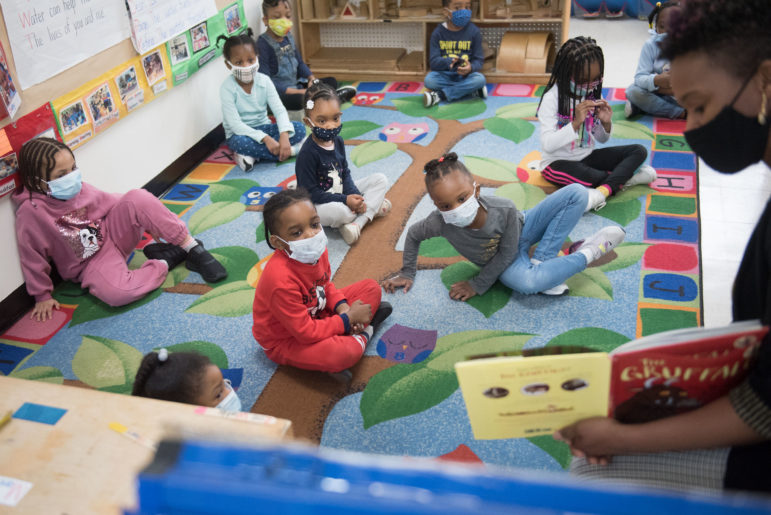The findings, released by anti-poverty nonprofit Robin Hood and Columbia University’s Center on Poverty & Social Policy, examined the impact of the Early Learning Child Care Act, which would institute a payroll tax to fund child care subsidies for families with children under 3 years old.

A bill that would expand eligibility for child care subsidies in the state, currently under consideration in the legislature, has the potential to lift some 84,000 New Yorkers out of poverty and boost the income of tens of thousands of families, a newly released analysis found.
The findings, released by anti-poverty nonprofit Robin Hood and Columbia University’s Center on Poverty & Social Policy, examined the impact of the Early Learning Child Care Act, which would institute a payroll tax to fund child care subsidies for families with children under 3 years old.
The bill, introduced in December by State Sen. Jessica Ramos and Assembly Member Sarah Clark, would expand eligibility for fully-subsidized child care to families earning up to 400 percent of the federal poverty line, or $106,000 a year for a four-person household. Higher income families would also be eligible for subsidized care, paying a sliding scale fee but never more than 7 percent of their income, according to the legislation.
That’s a big difference from the city’s current childcare reality, where the cost of daycare for an infant is equivalent to a third of the annual salary of a single parent working full-time at the minimum wage. New York’s current childcare subsidies are also only available to households earning up to 200 percent of the poverty level, or $53,000 for a family of four, according to a comptroller’s office report.
If the state implemented the bill’s changes, it would reduce New York’s poverty rate by 2.7 percent and child poverty by 12 percent, according to Robin Hood and Columbia’s analysis. It would increase the income of 1.2 million families across the state, including 906,000 families with kids under 3 who would see their average salary increase by $2,100 a year.
It would also mean higher wages for child care workers themselves, a largely women-led industry that experts say has long suffered from low pay, fueling a shortage of providers across the state. The bill would create a baseline pay of $45,000 a year for child care providers, which the Columbia/Robin Hood analysis says would benefit 277,000 workers who would see their average incomes increase by 21 percent.
Supporters say a greater investment in child care would also help fulfill new Mayor Eric Adams’ call for more New Yorkers to return to work in physical offices after nearly two years of the pandemic. The bill would allow 76,000 single parents or secondary earners to re-enter the workforce, the analysis found.
“[I]nvesting in child care would jumpstart our economic recovery and lift tens of thousands of our neighbors out of poverty—in other words, it’s an investment in our future,” Robin Hood CEO Richard R. Buery, Jr. said in a statement.
The Early Learning Child Care Act is one of two pieces of state legislation under consideration this session that aims to overhaul New York’s child care system, which advocates say was in crisis long before the pandemic, with the cost of care often unaffordable for even middle-income families and a shortage of providers across the city (half of all the city’s community districts qualify as “infant care deserts,” a 2019 comptroller report found).
While former Mayor Bill de Blasio invested heavily in establishing free universal pre-k and 3-k, major gaps in the system remain, particularly for families with children under 3 and parents who work nights or weekends.
“That program is good until 3 p.m. and is done in June. There’s not really a lot of options for extended hours of care,” said Nora Moran, director of policy and advocacy at United Neighborhood Houses. The pandemic has further strained the industry, which serves a population of kids still too young to be vaccinated. “The last few years have not been easy for childcare providers, between centers opening, closing, enrollment being all over the place.”
Moran said the Ramos/Clark bill would be a positive step forward, as would another bill introduced by State Sen. Jabari Brisport, which would establish a state taskforce charged with developing and implementing a free and universal child care system, to be phased in over four years. The Universal Child Care Act would also aim to do away with means-testing, rules that currently require families to work a certain amount of hours to qualify for subsidies.
Brisport and dozens of other lawmakers are calling for Gov. Kathy Hochul to invest $5 billion in this year’s budget to “enable New York to take critical steps toward achieving universal child care.”
The officials and other child welfare advocates say they were disappointed in Hochul’s executive budget unveiled last month, saying it doesn’t go far enough to address the extent of the crisis. The governor proposed expanding eligibility for the state’s child care subsidies, bumping the income threshold from families earning up to 200 percent of the federal poverty level to those earning up to 300 percent, rolled out over three years.
“This is not a strong start,” the coalition of lawmakers said in a statement. Moran criticized the gradual rollout, saying eligibility expansions should take place immediately. “Why wait? There are families who right now can’t access care because they make a couple of dollars over the income limit,” she said.
Hochul’s proposal would also invest $75 million in federal stimulus funds to support the child care workforce and increase workers’ wages (a quarter of child care workers in New York City live in poverty, according to the comptroller’s report). Moran said that investment is “certainly not enough,” while lawmakers are calling for the state to create a $1 billion workforce compensation program for the industry.
“New York could draw upon the full $200 million in federal child care stabilization funds it has on hand now to support this fund for the short term while the State pursues a long-term strategy to raise child care workforce salaries,” the legislators’ statement said.
Advocates’ say Mayor Eric Adams preliminary budget likewise did not do enough to address the child care crisis. The mayor—who on the campaign trail pledged to create a city-funded child care program—included $25 million in his spending plan for a tax abatement for property owners who retrofit their buildings for child care space, and another $25 million to cover tax credits for businesses that offer free or subsidized child care to workers.
But advocates say they would have liked to see a more direct investment in increasing capacity.
“The budget fails to address the dearth of affordable infant and toddler care and the lack of extended-day/extended-year seats in 3K and UPK programs, expand year-round youth services for school-age children, or invest in summer camps,” Jennifer March, executive director of the Citizens’ Committee for Children (a City Limits’ funder) said in a statement.








